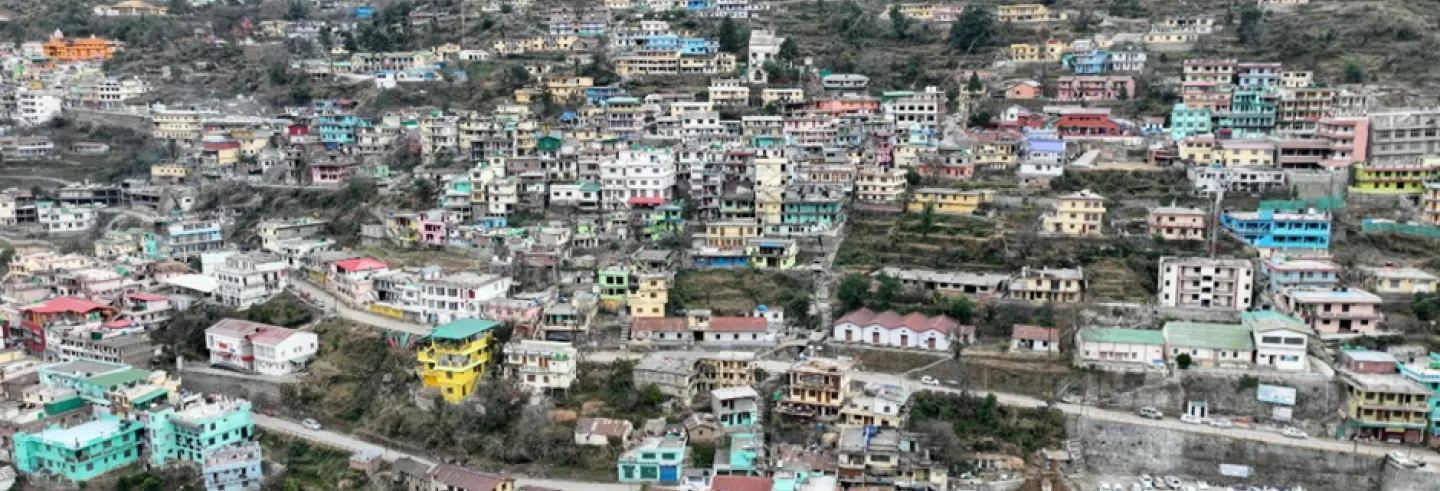Calamity struck the Himalayan town of Joshimath when torrents of water gushed out of its lower slope on the night of 2 January 2023. Perched on a hill at an altitude of 6,150 feet (1,875metres), parts of the town subsided, cracks appeared on buildings, and roads and fields and buildings tilted dangerously. Huge fissures near a tower of the ropeway to the Auli ski resort saw the service being suspended.
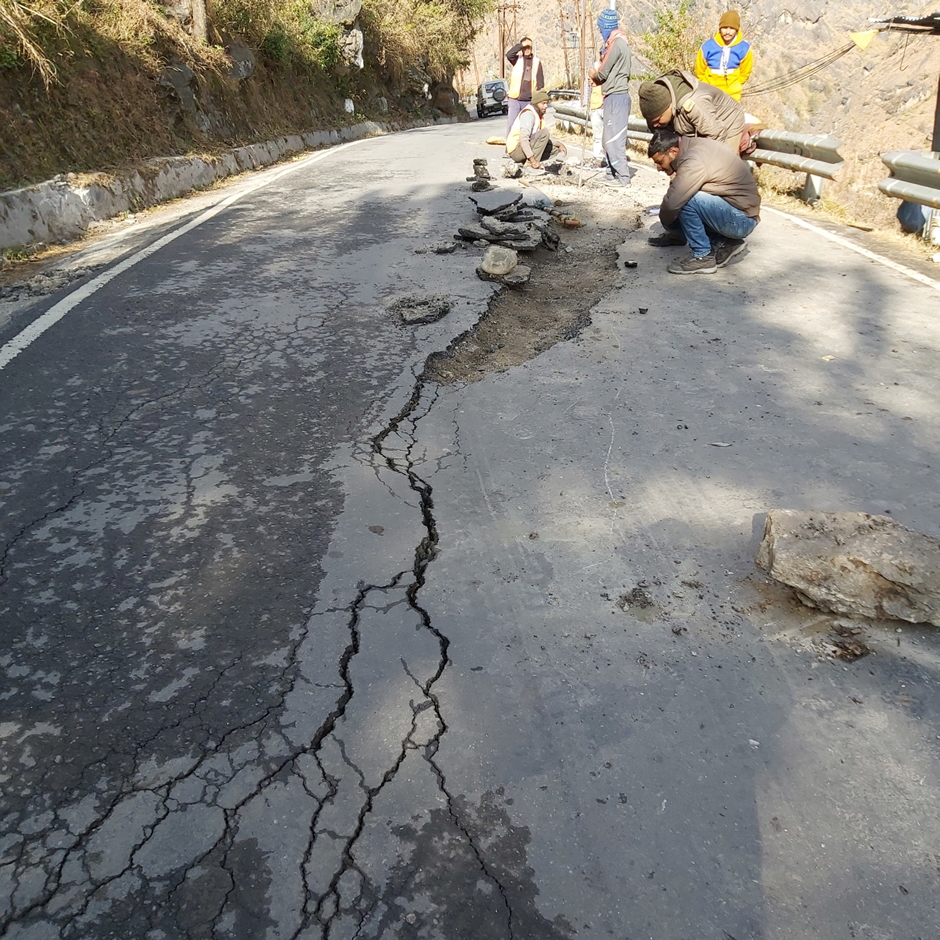
On 13 January, the Indian Space Research Organisation (ISRO) released a preliminary report revealing that while Joshimath had subsided about 9 cm between April and November 2022, it dropped 5.4 cm in just 12 days—from 27 December to 8 January.Two days later, the report was removed from the National Remote Sensing Centre’s website. The National Disaster Management Authority prohibited government research bodies from publicising any information on the Joshimath situation. As residents of the town panicked and routine activities came to a standstill, district, state, and central government officials and the media finally began to pay attention.
Joshimath is an important town. The Jyotirmath there was founded by Adi Sankaracharya as one of the four major mathas (monasteries) of the Hindu religion between the 8th and 9th centuries CE. It is the gateway to the Hindu and Sikh shrines at Badrinath and Hemkund Sahib, respectively. Every winter, the idol of Lord Badrinarayan is brought from snowbound Badrinath to the Narsingh temple in Joshimath.
On 13 January, the Indian Space Research Organisation (ISRO) released a preliminary report revealing that while Joshimath had subsided about 9 cm between April and November 2022…
After the Indo-China war in 1962, an army base was established in Joshimath and motorable roads were built. It also became a tourism centre for visitors to the Valley of Flowers, the Nanda Devi National Park, and the ski slopes of Auli.
Slope Destabilising Factors
In 1936, Swiss geologists Arnold Heim and Augusto Gansser observed that Joshimath was located on the debris of an ancient landslide near the Main Central Thrust (MCT), a seismically active Himalayan fault zone. Even micro-seismic tremors can add to slope destabilising stresses in regions such as these.
The abrupt change in elevation and steepness around Joshimath because of the MCT leads to high rainfall and high water erosion rates. Water flowing through the weakly bonded soil and debris causes erosion and creep, or sliding, of the slope. The Alaknanda and Dhauliganga rivers tend to erode the base of Joshimath’s slopes, adding to their instability.
Most local people are convinced that the recent slope movement is due to excavations for the 12.25-km head race tunnel through the Joshimath mountain for the National Thermal Power Corporation (NTPC)-owned 520 MW Tapovan-Vishnugad hydroelectric project. About 8.5 km of the tunnel is being excavated with a tunnel boring machine and the remaining 4 km by drilling and blasting.
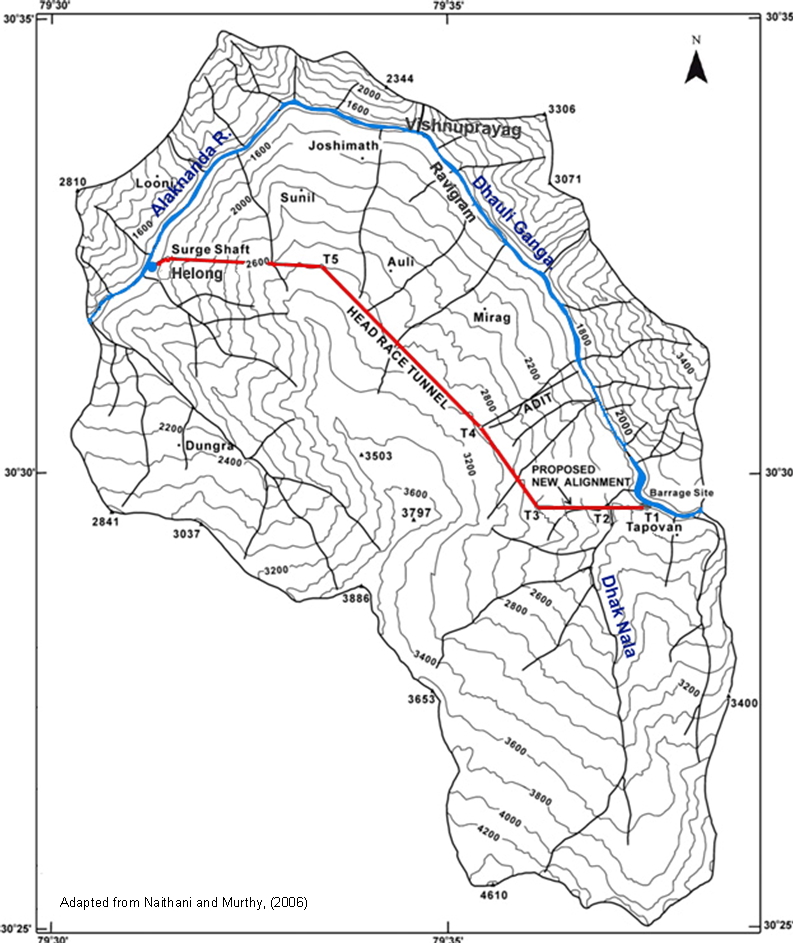
The boring machine has been trapped inside the tunnel three times—in December 2009, February 2012, and October 2012. Two Garhwal University geologists, who studied the first accident, published a note in Current Science, saying that sudden massive water discharge from the slope led to the puncturing of an aquifer under the town (Bisht and Rautela 2010).
A technical report by three German engineering consultants revealed that heavy ingress of water into the tunnel after each accident had opened and widened fractures beyond the tunnel walls (Millen et al. 2015). Following this logic, it can be suspected that the heavy flood in February 2021—laden with sediments, rocks and boulders—slammed into the tunnel, opening and widening more fractures outside the tunnel walls.
The NTPC, however, denies that its head race tunnel has destabilised Joshimath. It argues that the tunnel lies at a horizontal distance of 0.85 km to 1.2 km away from the town and at depths varying from 0.65 to 1.1 km (NTPC undated).
But the Joshimath Bachao Sangharsh Samiti (JBSS), a local citizens’ organisation formed about 20 years ago, asserts that a bypass tunnel was excavated with explosives right below the town to rescue the boring machine that had been trapped inside the main tunnel. “These explosions, which continued until recently, are the main cause of the present land subsidence,” says Atul Sati, convenor of the JBSS. “The other factors have simply added to these stresses.”
Massive explosions for the Helang-Marwari bypass, which is being constructed under the Central government’s ambitious Char Dham Pariyojana road-widening project, and erosion at the foot of Joshimath’s slopes had done further damage by the February 2021 flood, according to local residents. Eyewitnesses said the water level rose about 20 metres before subsiding. Severe erosion most likely increased the soil creep rate, leading to the appearance of cracks on Joshimath’s buildings in November 2021.
In 2019, almost 500,000 tourists visited Joshimath during the season, and forests were felled for the ropeway to the Auli ski slopes. This infrastructure project, along with inadequate drainage for the town’s wastewater, is thought to have severely burdened the slope.
After Uttarakhand state was formed in November 2000, Joshimath grew rapidly with little concern for its carrying capacity. Its resident population has swelled from about 13,200 in 2001 to nearly 25,000 today. The Indian army, the Indo-Tibetan Border Police (ITBP), the Border Roads Organisation (BRO), and the Jaypee Hydro campus are the major establishments in Joshimath, in addition to many hotels and guesthouses.
In 2019, almost 500,000 tourists visited Joshimath during the season, and forests were felled for the ropeway to the Auli ski slopes. This infrastructure project, along with inadequate drainage for the town’s wastewater, is thought to have severely burdened the slope.
Governments in Denial
Fissures and cracks began appearing on Joshimath’s roads as far back as the 1970s. In 1976, a government committee headed by Garhwal Commissioner M.C. Mishra investigated the causes of land subsidence and recommended remedial measures. It cited deforestation, unplanned construction of buildings, road construction using explosives, inadequate drainage of domestic wastewater, and erosion at the base of Joshimath caused by the Dhauliganga and Alaknanda rivers as the main causes of land subsidence (Pahari 2005).
The committee recommended conducting a survey that would designate stable and unstable zones, bans on tree-felling and heavy construction in the sliding zones, and permitting only limited construction in safe areas. It also recommended that the toe of the hillslopes be protected against scouring by the rivers. These recommendations were ignored.
In December 2003, local citizens wrote to the President of India and the Governor of Uttarakhand that blasting for the Tapovan-Vishnugad head race tunnel would damage their houses and fields. They sought assurances that their concerns would be addressed (Sati 2023). The President’s office requested the NTPC to allay the people’s fears but there was no response from the corporation.
In 2014, an Expert Body appointed by the Union Ministry of Environment and Forest recommended that no hydropower projects be constructed in the paraglacial zone…
After the Tapovan-Vishnugad tunnel received environmental clearance in 2007, the JBSS again wrote to the President of India, citing instances of slope destabilisation at other nearby tunnels and seeking a review of the NTPC’s project by a high-powered committee.
A 2006 report by the Dehradun-based Wadia Institute of Himalayan Geology (WIHG) revealed that the villages of Kamet and Sema and the town of Joshimath were sliding 1 cm every year. It warned, “Some families in the ward of Ravigram have already shifted. Yet, three-four families remain who have to be shifted soon.”Last month, a newspaper reported that Swapnamita Choudhury’s team at the WIHG measured a soil creep rate of 8 cm per year in Ravigram ward. The creep rate in Ravigram and Sunil wards was faster than in the others.
After the boring machine was first trapped inside the tunnel in December 2009, Garhwal University geologists investigating the accident wrote in Current Science, “The sudden and large-scale dewatering of the strata has the potential of initiating ground subsidence in the region.” They warned that the long-term implications of the event “were sure to be serious” (Bisht and Rautela 2010). Rautela later became the head of Uttarakhand’s Disaster Management and Mitigation Centre (DMMC) while Bisht headed Uttarakhand’s Space Applications Centre (USAC).
A prolonged campaign against the NTPC by the JBSS and an intervention by the Union Power Minister forced the corporation into agreeing to insure all houses in Joshimath against damage and to ensure the sustained supply of water to families affected by the drying of their spring sources. The assurances were not fulfilled. A high-powered committee, formed after the JBSS had demanded a review of the Tapovan-Vishnugad project, never met. “This put a question mark on the future of Joshimath,” says Atul Sati.
In 2014, an Expert Body appointed by the Union Ministry of Environment and Forest (MoEF) recommended that no hydropower projects be constructed in the paraglacial zone, north of the MCT (Ministry of Environment, Forest and Climate Change 2014). The MoEF first accepted the body’s report and all its recommendations but later reversed its decision.
On 7 February 2021, disaster struck. The Rishiganga hydroelectric project, and the Tapovan-Vishnugad project’s barrage were destroyed and the tunnel was flooded, killing 217 people. Had the expert body’s recommendation been honoured, this disaster would not have occurred.
In 2021, the Government of India decided to restart construction work at seven hydroelectric projects in Uttarakhand ... More than 60 Indian scientists and other eminent citizens wrote two times to the Prime Minister urging him to cancel all seven hydroelectric projects.
In 2016, the Uttarakhand government commissioned a state-wide disaster risk assessment survey. The final report recommended that strategic disaster mitigation plans be prepared for severely threatened locations, including Joshimath (DRA JV Team 2019). But the state did not act on this.
In 2021, the Government of India decided to restart construction work at seven hydroelectric projects in Uttarakhand. Six of these were in the paraglacial zone, including the Tapovan-Vishnugad project. More than 60 Indian scientists and other eminent citizens wrote two times to the Prime Minister urging him to cancel all seven hydroelectric projects (Koshy 2021). The decision was not changed.
On 3 October 2022, the JBSS wrote to the Prime Minister that construction of the Helang-Marwari bypass, which was then under way, would add to Joshimath’s growing instabilities. The signatories urged him to halt the project and instead strengthen the traditional route through Joshimath. But massive explosions continued night after night.
Disaster Compels State Action
Incidents of soil creep and land subsidence grew in number from November 2021. The JBSS repeatedly informed the district administration and the state government of Joshimath’s increasingly precarious situation, demanding a comprehensive scientific survey of the areas where land had subsided.
With no response from the government, the JBSS received help from some well-known independent scientists who conducted their own survey. They submitted a formal report to the JBSS and the people of Joshimath in July 2022, identifying all the above-mentioned destabilising factors (Sati et al. 2022).
This forced the state to appoint an official committee of scientists to survey the area and draft a report. Their September 2022 report largely reiterated the observations of the 1976 Mishra Committee, recommending that seriously damaged houses be vacated and the families relocated. Both reports recommended halting further construction work (Rautela et al 2022).
The state government’s lack of concern notwithstanding, cracks began appearing in buildings at an accelerated rate. By early December 2022, the walls and floors in hundreds of houses had split. Many families took to supporting their roofs with wooden poles. Others left Joshimath altogether, fearing catastrophe.
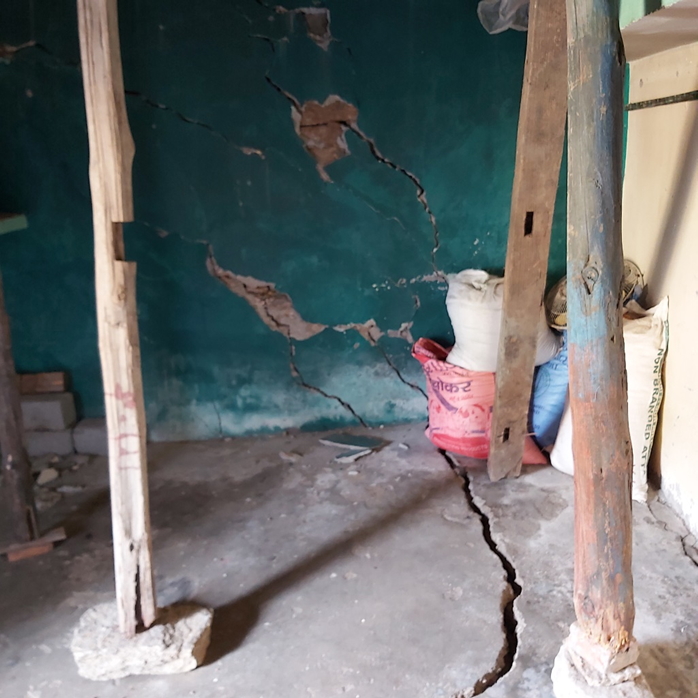
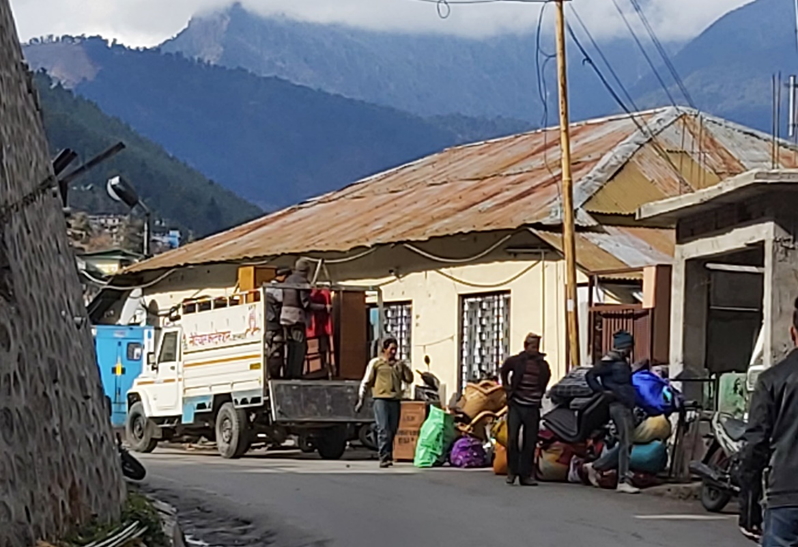
On 24 December, after a major hotel building began to tilt ominously, a crowd of more than 2,000 people held a torchlight protest march in the cold wintry night, demanding immediate resettlement of the people whose homes were damaged beyond repair. The Disaster Management Department’s response was to call a meeting on 15 January.
A huge discharge of water and subsidence inside the JP Hydro colony on the night of 2 January finally moved the state and central governments to act.
The JBSS complained to the State Disaster Management Secretary on 28 December that 15 January was too late and urged immediate resettlement of the people on the basis of a Nagarpalika survey of unsafe buildings. Meetings of local citizens, their MLA, and the Nagarpalika chief with the state BJP chief and the Chief Minister in Dehradun on 1 January, however, ended with only a vague assurance of “looking into the matter”.
A huge discharge of water and subsidence inside the JP Hydro colony on the night of 2 January finally moved the state and central governments to act. On 4 January, the Chamoli district administration announced that 561 buildings were severely damaged. Following a chakka jam (road blockade) in the town on 5 January, orders were issued to the NTPC, BRO, and other contractors to halt all construction (Sethi 2023a).
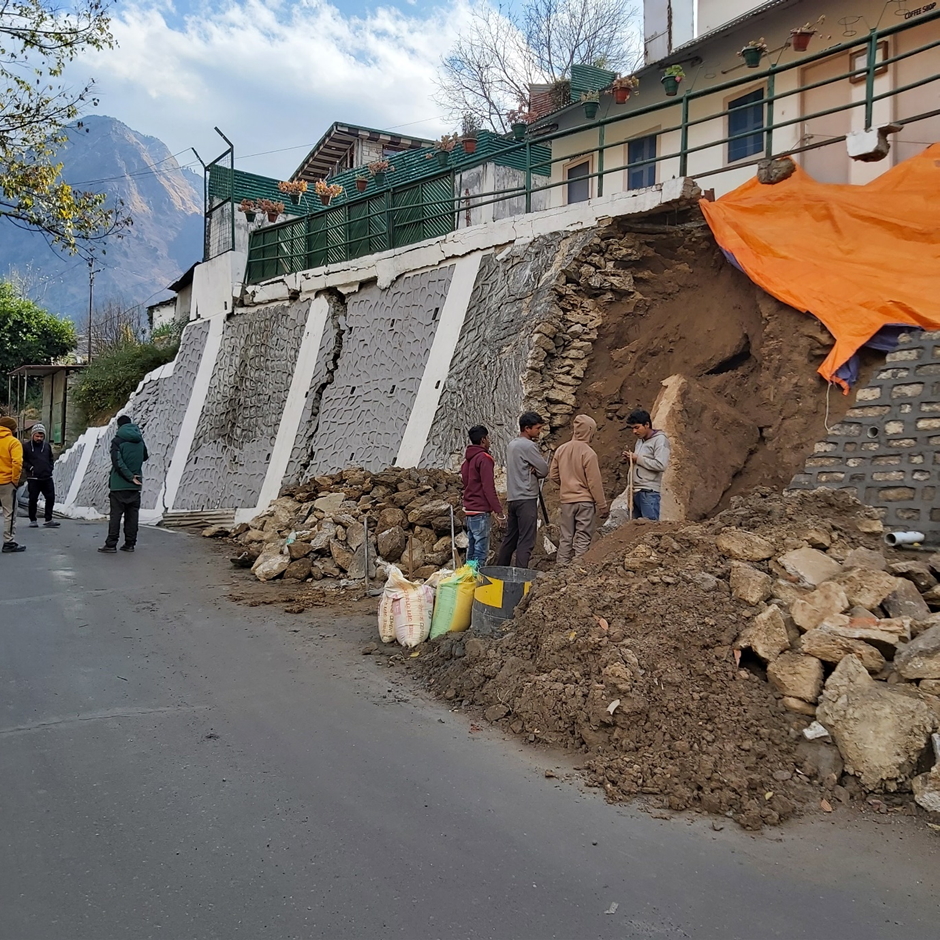
Chief Minister Pushkar Singh Dhami arrived in Joshimath on 7 January and visited the homes of a few affected families. The next day, the Prime Minister's Office (PMO) directed eight central organisations to study the causes of land subsidence in Joshimath and submit their recommendations for remedial measures in two weeks.
Chief of the Army Staff General Manoj Pande announced on 12 January that more than 20 military installations in Joshimath had sustained “medium to minor damage” and that soldiers had been relocated from the town. He added that this would not affect the Army’s operational readiness (Sethi 2023b). On 13 January, the Uttarakhand Cabinet announced a series of interim relief measures for disaster-affected families.
Rooms in schools, army buildings, the Nagarpalika guesthouse, religious establishments and hotels, an auditorium, and a few halls were requisitioned as relief centres. By the end of January, more than 860 buildings were declared disaster affected and 181 were marked unsafe, presumably to be demolished. Food and shelter (generally one room per family) were provided at the relief centres.
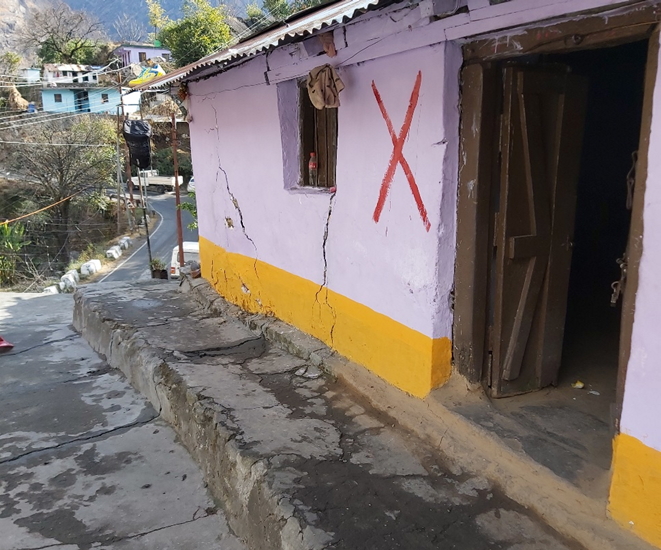
Initially, 278 families—owners of unsafe homes and their tenants—moved into the relief centres. Hotel owners, whose rooms had been requisitioned, soon began facing difficulties. Many of their staff had left the town and they were worried about getting paid. The families accommodated in hotels often had to cook their own meals and live without heat in the extremely cold winter. By the end of January, more than 30 families shifted to rented accommodation while 902 people remained in the relief centres.
It is hard to understand the government’s response to Joshimath’s crisis. The delay in acknowledging it was inexplicable. Perhaps the government was trying to downplay the situation so that the summer tourism economy, based on the Char Dham yatra, is not hurt.
Anxiety about their immediate resettlement and long-term rehabilitation remains paramount among the local people. On 30 January, a high powered committee met with Additional Chief Secretary Radha Raturi in the chair and gave in-principle approval to three rehabilitation proposals received from the Chamoli district administration.
Government Response
The State and Central governments’ response to Joshimath’s current crisis can be characterised as delayed, halting, misleading, and timid.
It is hard to understand the government’s response to Joshimath’s crisis. The delay in acknowledging it was inexplicable. Perhaps the government was trying to downplay the situation so that the summer tourism economy, based on the Char Dham yatra, is not hurt.
While senior state officials periodically issue reassuring claims, these are immediately contradicted by what is seen by the local people and shared on social media as well as information released by official agencies. On 11 January, the Principal Secretary to Uttarakhand’s Chief Minister told a news agency that no new cracks had developed since 7 January. Only a week later, this was contradicted by the Secretary, Department of Disaster Management, who said that the number of houses with cracks had in fact risen (Anon 2023a, Anon 2023b).
Similarly, reports of action being taken by the state are greeted with scorn. On 5 January, for example, the Chamoli district administration grandly announced that it had directed the NTPC and its contractor, Hindustan Construction Corporation, to build 2,000 prefabricated units to shelter families (Sethi 2023a). Although the Union government approved their construction on 14 January, as of 14 February, not a single unit had been built.
There has been little direct communication between the ruling party’s leadership and the affected residents. State ministers and ruling party leaders have met with selected local people behind closed doors, even as residents have sat in disciplined protest at the tehsil office day after day since the beginning of January, braving the cold, rain, and snow. Information about relief measures and resettlement and rehabilitation plans is mainly provided by the media. A gag order by the National Disaster Management Authority (NDMA) has prohibited government bodies from releasing scientific information and data. Such orders diminish public institutions and erode democracy.
It is shocking that in a disaster-prone state such as Uttarakhand, which has had a Department of Disaster Management for more than 20 years, disaster response readiness was zero.
Larger Lessons
Joshimath is only one among many Himalayan towns and cities—Dharamshala, Shimla, Uttarkashi, Mussoorie, Gopeshwar, Nainital, Gangtok, and Darjeeling, to name a few—that are threatened by soil creep, landslides, and ground subsidence. A combination of ecological factors such as steep slopes, high rainfall, deforestation, overloading of soils with limited load-bearing capacity, and geological infirmities is responsible for the structural instabilities seen in these towns.
The stability of India’s mountain towns also falls prey to ill-conceived infrastructure projects. These include hydroelectric projects, construction of roads as wide as in the plains, tunnelling for extending the railway, and other infrastructure construction.
Planning based on a careful assessment of an area’s carrying capacity is the first requirement for safe urban development in the mountains. Yet this is not done as a part of urban development planning in India’s mountain regions. The stability of India’s mountain towns also falls prey to ill-conceived infrastructure projects. These include hydroelectric projects, construction of roads as wide as in the plains, tunnelling for extending the railway, and other infrastructure construction.
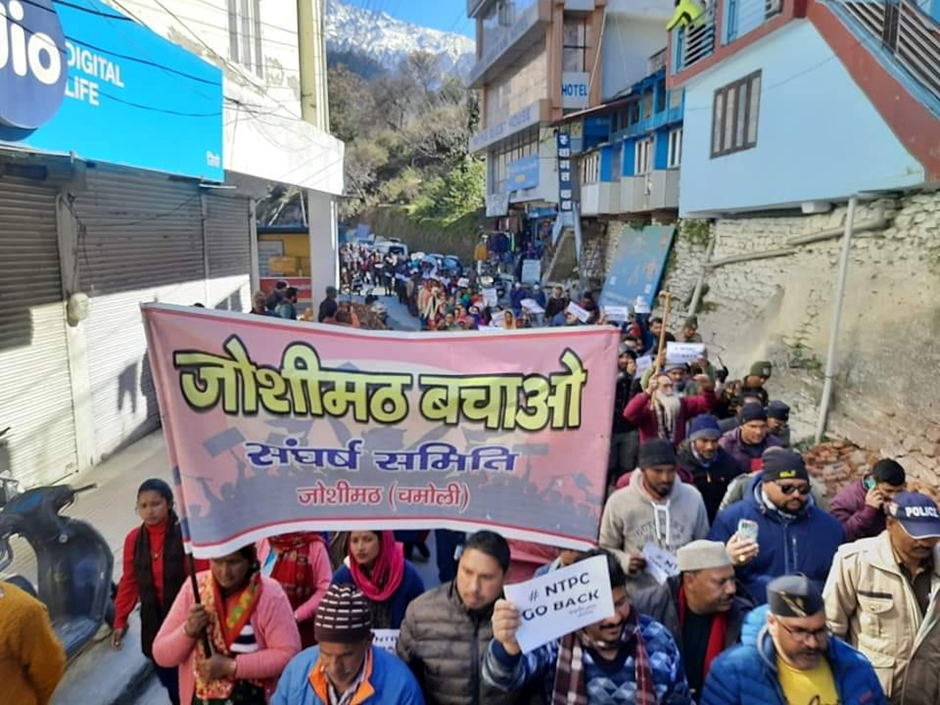
This does not mean that there should be no infrastructure development in the mountains. Well-known geophysicist V.K. Gaur (2023) has argued that the region’s perceived weaknesses should be carefully measured and projects designed within the limits defined by the measurements.
For example, in 2012, the policy for constructing national highways in India laid down a 10-metre tarred surface as the standard width. But, in 2018, the Ministry for Road Transport reduced the road width in the mountains because experience has shown that constructing wide highways destabilises more slopes, increases the loss of forests, trees, and biodiversity, swells river pollution and clogs streams with large quantities of soil, debris, and muck. The follow-up measures inevitably caused delays and increased project costs.
The knowledge and experience of the local people combined with a sound understanding of geology, ecology, and the changing climate are essential for building disaster resilience into Himalayan infrastructure projects. Infrastructure projects can no longer be designed based only on past weather trends and data. They must also incorporate safety factors for future extreme weather events.
Climate change certainly demands rejecting the present no-holds-barred economic growth model.
In the past, experts, activists, and conscientious officials worked together to develop legal safeguards such as the rules and regulations in the Environmental Protection Act. But in recent decades governments have steadily watered these down, more so since 2014. Weakened laws have made the judiciary less effective while budgetary constraints have reduced the effectiveness of regulatory agencies. The increasing frequency and ferocity of extreme weather events, however, requires more prudent safeguards.
Climate change certainly demands rejecting the present no-holds-barred economic growth model. The latter, however, is slickly advertised to seduce a sizable well-to-do class into ever increasing consumption. The benefits of this model flow only one way—to the rich. The injured hinterland is left alone to deal with all resulting disasters.
There is a saner model of development based on growing in harmony with nature. Such a model can also yield rapid growth while sustainably increasing the productivity of our natural resources and sharing them more equitably. This will be possible only when communities have control over their local natural resources.
Slope subsidence in Joshimath was a disaster waiting to happen. It is both criminal and tragic that it was allowed to happen.

